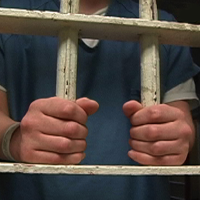California Prisoners Killed at Twice the National Rate and Sex Offenders Fare the Worst

California prisons have been notoriously overcrowded for years and the subject of countless federal court orders to reduce the population to at least 137.5% of capacity.
So, perhaps, it is not surprising to find, as the Associated Press did, that the homicide rate for California state prison inmates is double the national average. Of the 672 homicides in state prisons nationally from 2001-2012, 162 were in California. Nobody else had more than a third that number. Florida had 52, Texas 50, and Georgia and Oklahoma tied at 39.
When the numbers are adjusted for California's hefty supply of prisoners, it works out to 8 homicides per 100,000. The national average is 4. Oklahoma is the leader at 14, followed by Maryland (11), Tennessee (9), New Mexico (9), South Carolina (8) and Maine (8). Six states had zero: Minnesota, New Hampshire, North Dakota, Vermont, Wisconsin and Wyoming.
California's prison homicide victims are disproportionately male sex offenders. They are 30% of the victims, but just 15% of the prison population, according to statistics since 2007, when Corrections officials started releasing information on the victims.
Paradoxically, prison officials attributed the high homicide rates, in part, to recent reductions in the California prison population. The state adopted a realignment strategy three years ago to reduce the prison population by directing low-level felons and parole violators to county jails. The result is a higher percentage of the most dangerous prisoners in state institutions.
Prison consultant James Austin told the Associated Press, “Until the state gets its prison population below 100 percent of capacity, you’re going to have this.”
While the high homicide rate reflects badly on the state's correctional institutions, it is not half the suicide rate of 20 per 100,000 prisoners. Death by homicide is even with deaths related to alcohol and drugs in state lockup, a place where one might expect access to be somewhat limited.
Illness is by far the greatest cause of death in California prisons, where the overall rate is 228 per 100,000. The cancer rate is 53, followed by heart disease (39), liver disease (25), respiratory disease (16), AIDS-related illness (6) and “other” (48).
California has successfully whittled away at its prison population, despite outcries from law-and-order types that early-release of criminals, shorter prison sentences, and more liberal use of probation and parole will increasingly endanger the public. Last month, the state reported that, for the first time, it had dipped below court-ordered prison population level.
The state's prisons were built to house 80,000 inmates, but at one point held close to 160,000. The courts ordered that number be shrunk, in the short-term, to around 110,000, and weekly statistics from the California Department of Corrections and Rehabilitation (CDCR) indicate that the state slithered under the cap by about 300 prisoners.
Last week, a report from the Brennan Center for Justice reflected on the dramatic decline in crime nationwide. Violent crime is down 50% from 1990 levels. Property crime is off 46%. A victory for locking up the bad guys and throwing away the key back in the '80s and '90s? Not exactly.
An analysis of the stats by Brennan researcher Oliver Roeder at FiveThirtyEight found that the initial 5% drop in crime, when the added incarcerations began, quickly leveled off and hasn't really correlated with lower crime rates. Their conclusion was that once the worst of the worst were imprisoned, tossing the lesser offenders in prison for repeated, lengthy stays did help society much.
“A state’s change in incarceration is not strongly linked with its change in crime; one doesn’t seem to have much to do with the other,” Roeder wrote.
‒Ken Broder
To Learn More:
California Inmates Killed at Rate Double National Average, Sex Offenders Among Most Targeted (by Don Thompson, Associated Press)
Mortality in Local Jails and State Prisons, 2000–2012 (by Margaret E. Noonan, U.S. Department of Justice)
California's Prison Population Is Finally Down, but Will It Last? (by Sharon Bernstein, Reuters)
The Imprisoner’s Dilemma (by Oliver Roeder, FiveThirtyEight)
What Caused the Crime Decline? (by Oliver Roeder, Lauren-Brooke Eisen and Julia Bowling, Brennan Justice Center)
Judges Give Overcrowded, Unhealthy California Prisons a Two-Year Reprieve (by Ken Broder, AllGov California)
- Top Stories
- Controversies
- Where is the Money Going?
- California and the Nation
- Appointments and Resignations
- Unusual News
- Latest News
- California Forbids U.S. Immigration Agents from Pretending to be Police
- California Lawmakers Urged to Strip “Self-Dealing” Tax Board of Its Duties
- Big Oil’s Grip on California
- Santa Cruz Police See Homeland Security Betrayal in Use of Gang Roundup as Cover for Immigration Raid
- Oil Companies Face Deadline to Stop Polluting California Groundwater





